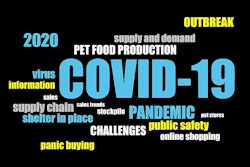
Feeding trials provide the “gold standard” for determining the energy content of pet food, but trials using live animals may be too expensive or otherwise unavailable when pet food formulators test products, Natalie Asaro nutrition assistant for Petcurean Pet Nutrition, said in a video from Petfood Forum (below).
“In a feeding trial you'd be able to figure out the actual amount of energy being provided to the animal,” she said. “Then you can also figure out the amount of energy being lost by that animal in terms of waste. That would be called metabolizable energy, which accounts for the waste loss in both feces and urine of the animal, but these trials themselves are expensive and they use animals so one of the things that we do with industry to cope with this is we use these calculations.”
Estimating energy in pet food
Pet nutritionists use what's known as the modified Atwater equation to predict the energy density of food, she said, rather than running feeding trials in every situation. However, the calculations used by pet food scientists don’t account for all the energy in the system.
“The models that we use in industry predict the metabolizable energy,” she said. “Net energy is a little bit of a different concept. There currently are no models to predict net energy of pet food. The reason being that net energy is actually much more complex to measure than metabolizable energy.”
In the Atwater equation, the metabolizable energy in pet food equals the gross energy in the edible item minus the energy lost in feces, urine and similar fluids or gases. However, dogs, cats and other warm-blooded pets have to keep their internal furnaces stoked. Scientists haven’t developed a means of estimating how much energy dogs and cats expend for membership in mammalia.
“Some of the work that we did involved measuring this heat loss in cats,” she said. “The best way to understand that is that the body needs to produce energy to use energy. When you're consuming a meal, your body
produces energy while breaking down that food. Net energy accounts for this heat loss, but it's very difficult to do currently. The study that we did is one of the first to look at the heat increment of cats.”
Although innovative, Asaro’s research hasn’t overturned pet food’s paradigm.
“Before altering any of the methodologies and the equations that are used currently, I think a lot more work needs to be done,” she said.














